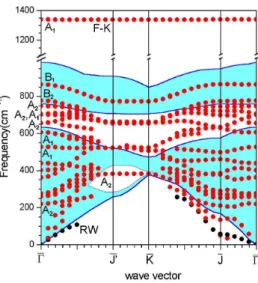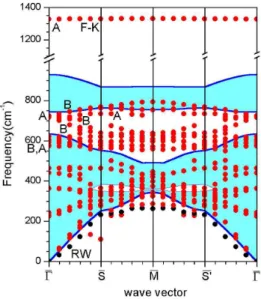302 Brazilian Journal of Physics, vol. 36, no. 2A, June, 2006
Ab Initio Determination of the (100) Surfaces Phonon Dispersions of the SiC
J. S. Soares and H. W. Leite Alves
Departamento de Ciˆencias Naturais, Universidade Federal de S˜ao Jo˜ao del Rei, Caixa Postal 110, 36300-000 S˜ao Jo˜ao del Rei-MG, Brazil
Received on 4 April, 2005
In this work, we presented our preliminaryab initioresults for the vibrational modes and the phonon frequen-cies of the SiC (100) surfaces. Our results are in good agreement with the available experimental data whenever this comparison is possible. For the accepted models of the C-terminated surfaces in the c(2×2) reconstruc-tion, while in the bridge-dimer model there is an acetylene-like vibrational A1mode at 2031 cm−1, which is
infrared active, in the staggered-dimer model, there is a F ¨uchs-Kliewer (FK) mode at 1328 cm−1, which is
ex-perimentally detected. For Si-terminated surfaces in the p(2×1) reconstruction, instead, no FK was obtained, in contradiction with the HREELS experimental results for the Si-terminated surfaces, but they are in consonance with the fact that this surface should be described by a (3×2) or more complex models.
Keywords:Ab initioresults; Vibrational modes; SiC (100)
I. INTRODUCTION
A great amount of efforts is spent to understand the growth mechanism of cubic GaN (and its alloys), which is the proto-type material for the optoelectronic devices operating on the visible part of the electromagnetic spectra. Many substrates were employed and, recently, (100) GaAs or SiC substrates were used with relative success [1,2].
Moreover, SiC is also the ideal material for the fabrication of semiconductor devices operating under extreme conditions [3]. So, the complete knowledge of their (100) surfaces prop-erties is a key for both successful growth of the III-Nitrides as well as for the preparation of the high-temperature microelec-tronic devices.
However, while the (100) surface electronic structures and structural properties of these materials were extensively stud-ied [4,5], the amount of knowledge on their dynamical prop-erties are rather scarce: only High-resolution electron energy-loss spectroscopy (HREELS) data were reported which op-tical F¨uchs-Kliewer (FK) phonon modes, that are completely determined by bulk properties, were characterized in these ex-periments [6,7].
It is well known that the evaluation of dynamical proper-ties of the solids, and of their surfaces, is a powerful tool to give a complete macroscopic characterization of the studied systems and, also, to check the accepted models [8]. So, in this work, by using the Density Functional Theory, within the local density approximation (LDA), based on the plane-wave pseudopotential method together with the slab-supercell de-scription (ABINIT code [9]), we have calculated, ab initio, the phonon dispersions of the C-rich SiC(100) surfaces, in the c-(2×2) and p(2×1) reconstruction patterns, and of the Si-rich SiC(100) ones, in the p(2×1) reconstruction model. We have used the Troullier-Martins pseudopotentials in the calculations (obtained with the fhi98PP code [10]), and the phonon dynamics were obtained by means the adiabatic per-turbation density functional theory, following our recipe used to describe phonons in GaAs (100) surfaces [11]. In the cal-culations, the slab supercells were build up of 5 atomic layers and a vacuum region equivalent of 5 atomic layers, and also, a
(4 4 2) Monkhorst-Pack mesh was used to sample the surface Brillouin zone. Details about the (100) surface equilibrium properties of both terminations of SiC were described in our previous work [12].
II. SI-TERMINATED SURFACES
In Fig. 1, we show the phonon dispersion of the Si-terminated SiC (100) surface in the p(2×1) reconstruction pattern, whose crystalline symmetry is Pm. From Fig. 1, we
found that there are, besides the Rayleigh mode (RW) (which arrives at ¯Jpoint with 103.2 cm−1, and at ¯K point with 343 cm−1), other three important Si-dimer vibrational modes lo-cated in the frequency gap: one mode with A” character at 710 cm−1 (at ¯Γ point), other A” mode at 562 cm−1 (at ¯J′ point), and one mode with A’ symmetry at 730 cm−1 (also at ¯Γpoint). It is interesting to remark that, in the calculated atomic displacement patterns of the modes at ¯Γpoint, the Si atoms vibrates parallel to the surface, while at the ¯J′ point, the Si atoms vibrates perpendicular to the surface, as depicted in Fig. 2, which we show the displacement pattern of the A” modes at both the ¯Γand ¯J′points of the Brillouin zone.
J. S. Soares and H. W. Leite Alves 303
FIG. 1: Calculated phonon dispersion for the Si-terminated SiC (100) (2×1) surface. The gray circles denote the surface modes, the black ones the Rayleigh wave (RW), while the hatched area are the pro-jected bulk results.
FIG. 2: Displacement pattern of the surface atoms for the gap A” mode at: (a) ¯Γpoint; (b) ¯J′point.
III. C-TERMINATED SURFACES
We show in Fig. 3, the phonon dispersion of the C-terminated SiC (100) surface within the p(2×1) reconstruc-tion pattern, and this system has the Pmm2crystalline symme-try. From Fig. 3, we found that there are, besides the RW (the lowest frequency mode, which arrives only at the ¯Jpoint with 58.9 cm−1), other five important C-dimer vibrational modes were obtained: three modes with A2character (the first at 748 cm−1, the second at 705 cm−1 and the third at 656 cm−1) and two A1 modes (one at 701 cm−1and the other at 1139 cm−1, respectively). The calculated high frequency A1mode is known as the FK one.
It is interesting to note, from the symmetry selection rules, that while all the calculated vibrational modes are Raman ac-tive, only the FK-like mode A1are infrared active. However, none of these kind of experimental results were reported in the literature. Also, we would like to remark that the RW is not present at allk-points of the surface Brillouin zone. As there
FIG. 3: Same as Fig. 1 for the C-terminated SiC (100) (2×1) surface. Here F-K denotes the F¨uchs-Kliewer modes.
FIG. 4: Same as Fig. 1 for the C-terminated SiC (100) c(2×2) sur-face in the BDM model.
are no references about this fact reported in the literature, we can infer, from our results, that this is an indication of the low stability of this reconstruction pattern, as already verified in our recent total energy calculations [12].
In Fig. 4, we show the phonon dispersion of the C-rich SiC(100) c(2×2) surface within the Bridge-Dimer Model (BDM), which also has the Pmm2crystalline symmetry. From Fig. 4, besides the RW (which arrives at ¯S point with 185.6 cm−1, and at ¯Mpoint with 111.5 cm−1), we have detected that there is an A1mode at 2031 cm−1, infrared active, with simi-lar character ofσGvibrational mode of the acetylene molecule
304 Brazilian Journal of Physics, vol. 36, no. 2A, June, 2006
this mode is the signature of the BDM, once no FK mode was obtained. Moreover, other four important C-dimer vibrational modes were obtained: two modes with A1 character (one at 668 cm−1and the other at 732 cm−1)and two B1modes (one at 735 cm−1and the other at 749 cm−1). These modes are all Raman active and only the A1modes are infrared active, by the selection rules.
FIG. 5: Same as Fig. 1 for the C-terminated SiC (100) c(2×2) sur-face in the SDM model.
We show, in Fig. 5, the phonon dispersion of the C-rich SiC(100) c(2×2) surface within the Staggered-Dimer Model (SDM), which has the P2crystalline symmetry. Also in Fig. 5, we have noted that, besides the RW (which arrives at ¯Sand ¯S′ points of the Brillouin zone with 232.7 cm−1), other four C-dimer vibrational modes were obtained: two modes with A character (one at 720 cm−1and the other at 1328 cm−1), and
two B modes (one at 716 cm−1, and the other at 725 cm−1). All modes in this system are both infrared and Raman active, and the higher A mode have the FK character.
It is interesting to note that the reported HREELS data on the C-terminated SiC surfaces [6] describes only the optical FK phonon modes. The experimental data of Balster et al. show this mode located at 958 cm−1, which is 38 % below our obtained values for the SDM. Considering that the total energy difference between BDM and SDM are small [5,12], and that the experiment were done at room temperature [6], we can infer, from our results, that Balsteret al. were dealing with the SDM model in their C-terminated SiC(100) c(2×2) surface.
IV. CONCLUSIONS
In summary, we have studied the vibrational modes of the p(2×1) reconstruction model for the Si-terminated surfaces, and for p(2×1) and c(2×2) reconstruction patterns within both BDM and SDM models for the C-terminated ones. For the C-terminated surfaces, while in the BDM there is an acetylene-like vibrational A1mode at 2031 cm−1, which is in-frared active, in the SDM, there is a FK mode at 1328 cm−1, in agreement with the experimental results. However, for Si-terminated surfaces in the p(2×1) reconstruction, no FK mode was obtained, in contradiction with the HREELS experimen-tal results for this surface. We hope that our results give guide-lines for future experiments on this subject, and a complete description of our obtained results will be published soon in another publication.
Acknowledgements
J. S. Soares acknowledges the Brazilian Program PIBIC/CNPq for the financial support. This work was also supported by the MCT/CNPq/PRONEX project No. 662105/98, Brazil.
[1] D. Troost, H. –U. Baier, A. Berger and W. M ¨onch, Surf. Sci. 242, 324 (1991).
[2] H. Okumura, H. Hamaguchi, G. Feuillet, Y. Ishida and S. Yoshida, Appl. Phys. Lett.72, 3056 (1998).
[3] R. S. Kern and R. F. Davies, Mater. Sci. Eng.B46, 240 (1997). [4] V. M. Bermudez, Phys. Stat. Sol. (b)202, 447 (1997), and
refer-ences therein.
[5] J. Pollmann and P. Kr¨uger, J. Phys. Condens. Matter16, S1659 (2004), and references therein.
[6] T. Balster, V. M. Polyakov, H. Ibach, and J. A. Schaefer, Surf. Sci.416, 177 (1998).
[7] H. Nienhaus, V. van Elsbergen, and W. M ¨onch, Eur. Phys. J. B9, 179 (1999).
[8] S. Baroni, S. de Gironcoli, A. Dal Corso, and P. Giannozzi, Rev.
Mod. Phys.73, 515 (2001).
[9] X. Gonzeet al., Comput. Mater. Sci.25, 478 (2002), and refer-ences therein.
[10] M. Fuchs and M. Scheffler, Comput. Phys. Commun.119, 67 (1999).
[11] H. W. Leite Alves, J. L. A. Alves, A. M. Santos, L. M. R. Scol-faro, and J. R. Leite, Braz. J. Phys.34, 617 (2004).
[12] J. S. Soares and H. W. Leite Alves, Microelectron. J.36, 998 (2005).
[13] P. Soukiassian, Mater. Sci. Eng.B96, 115 (2002); V. Derycke et al., Nature Materials2, 253 (2003).

